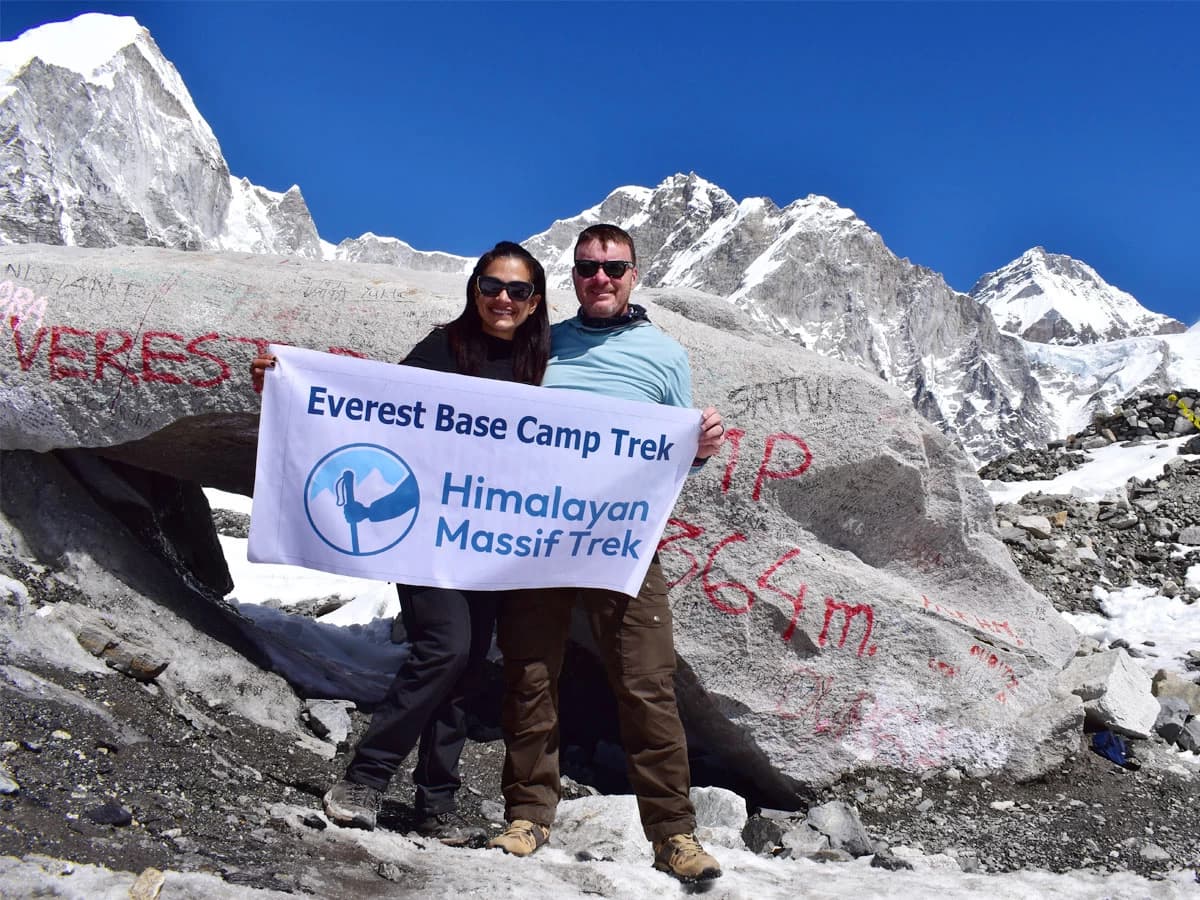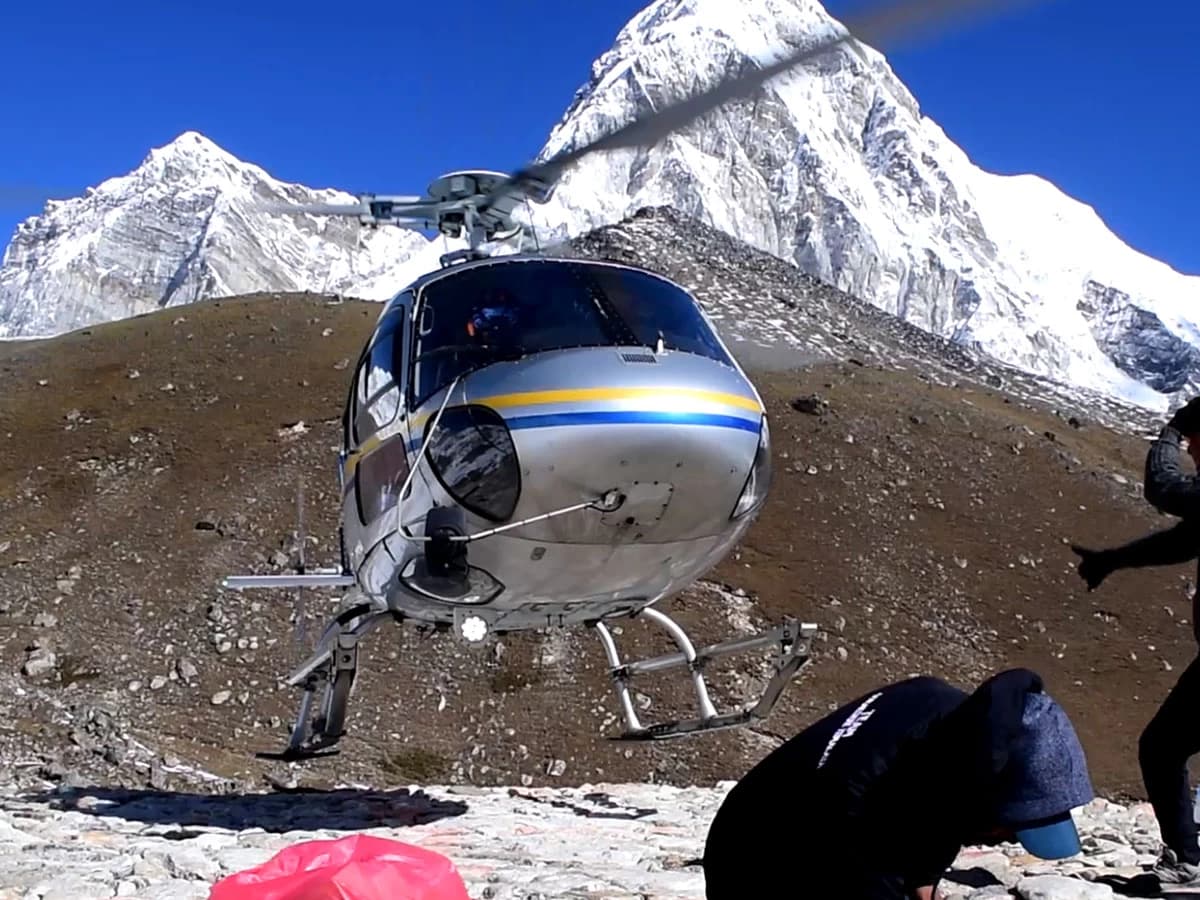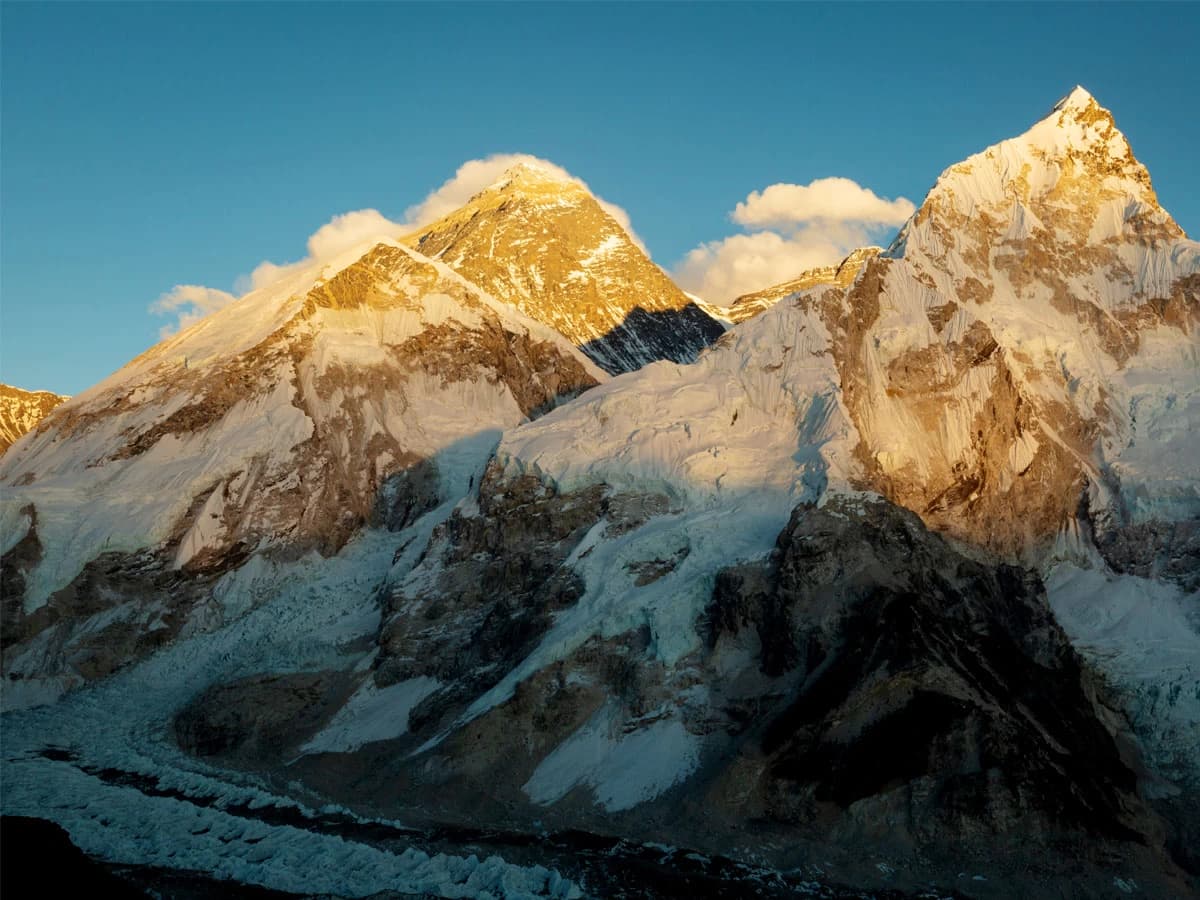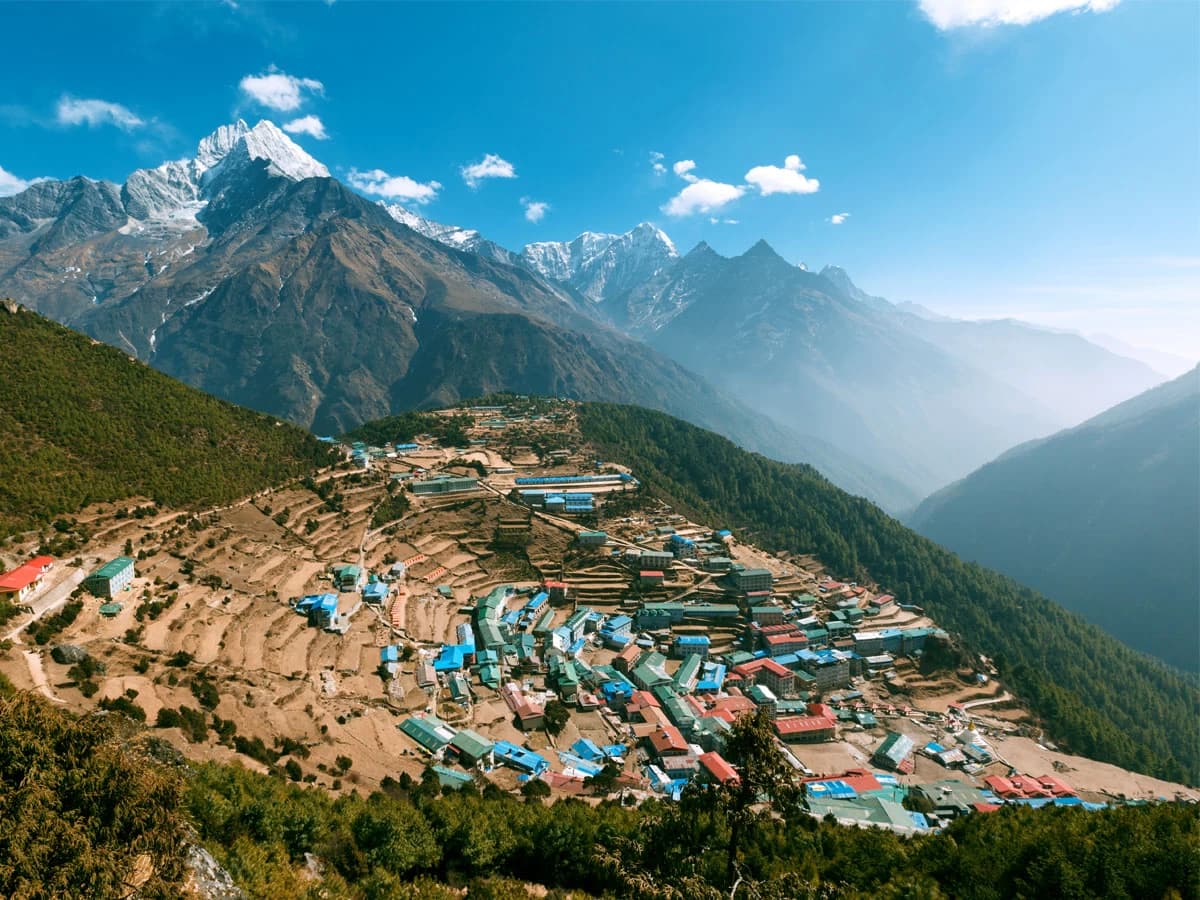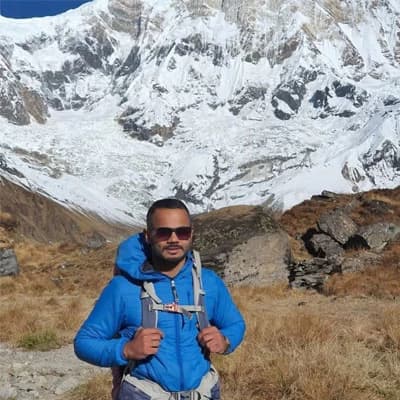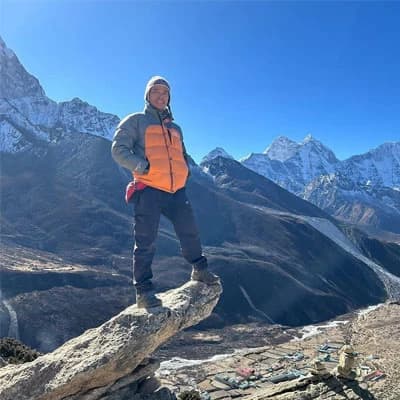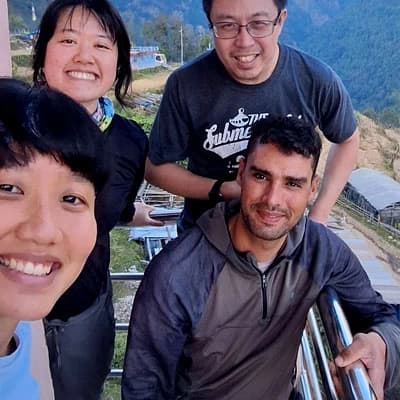The 7-Day Everest Base Camp Trek is a demanding adventure to the base camp of the world’s highest peak. This short and fast-paced 7-day itinerary has no acclimatization days and is best suited for seasoned trekkers with a portfolio of successful high-altitude treks. Starting your trek from Lukla, you’ll venture through iconic Sherpa villages like Namche Bazaar and Dingboche, enjoying glorious mountain views on your way to Everest Base Camp and the Kala Patthar viewpoint. The trek concludes with a helicopter ride from Gorakshep to Kathmandu, offering an aerial view of the region and a more convenient escape to Kathmandu.
Everest Base Camp Trek 7 Days
Highlights of the 7-Day Everest Base Camp Trek
- Fly from Kathmandu to Lukla, offering beautiful views of the Himalayas.
- Enjoy a helicopter ride with amazing views of Everest, the Khumbu Icefall, and Gokyo Lakes.
- Reach Kala Patthar (5,644 m) for an incredible view of Everest, Lhotse, Nuptse, and other big peaks.
- Stand at the base of Mount Everest, the tallest mountain in the world.
- Experience the Sherpa culture and meet friendly locals.
- Visit ancient monasteries like Tengboche and learn about Buddhist traditions.
- Walk past the Khumbu Icefall, the highest glacier on Earth.
- Explore Sagarmatha National Park, a UNESCO World Heritage site, with unique plants and animals.
- Visit Namche Bazaar, a lively town, visit the Sherpa Museum, and enjoy stunning mountain views.
Short 7-Day Everest Trek Overview
The 7-Day Everest Trek provides a fantastic chance to experience the beauty of the Himalayas and the Sherpa culture briefly. After a scenic flight to Lukla, you’ll trek through charming villages, visit monasteries, and see awe-inspiring peaks like Everest and Ama Dablam.
The trek is carefully planned for a comfortable pace, allowing you to enjoy the stunning surroundings without feeling rushed.
As you move through the Everest region, you’ll pass through notable spots like Tengboche, with its famous monastery, and Namche Bazaar, a vibrant market town. The trek takes you through Sagarmatha National Park, a UNESCO World Heritage Site, offering an immersive experience of both local culture and beautiful landscapes, ranging from lush forests to high-altitude terrain.
The main highlight of this trek is reaching Everest Base Camp and Kala Patthar, where you’ll be rewarded with incredible views of Everest and its neighboring peaks. This achievement offers a chance for reflection and connection with nature. To end your adventure, you’ll fly back to Lukla by helicopter, enjoying stunning aerial views of Cho La Pass and Gokyo Lakes. This trek is perfect for experienced trekkers who want a challenging experience with limited time for acclimatization.
Everest Base Camp Trek 7 Days Itinerary
Your adventure begins with an early morning flight from Kathmandu to Lukla, a thrilling 45-minute journey offering amazing views of the Himalayas. During peak trekking seasons, flights to Lukla often operate from Ramechhap instead of Kathmandu.
This alternate route helps avoid air traffic delays and offers shorter, more reliable flights. If this is the case, you’ll get on a road trip to Ramechhap beforehand. Don’t worry, though the Himalayan Massif Trek team will take care of all the arrangements, ensuring a smooth start to your journey.
Upon landing in Lukla, our porters will meet you and assist with your luggage as you set off toward Monjo, your first overnight stop. Interestingly, while there are some uphill sections, Monjo is actually at a lower altitude than Lukla.
The trail is pleasant, winding through stone and rocky paths with green pine forests and views of the Dudh Koshi River keeping you company.
After a fulfilling day, you’ll arrive at Monjo, where you can relax in a cozy lodge and enjoy an early night. It’s the perfect way to prepare for the exciting days ahead.
Your day begins with breakfast in Monjo before setting off along the trail that follows the Dudh Koshi River. The path winds through beautiful pine forests, past flowing waterfalls, and into the wilderness of Sagarmatha National Park. Named after Mount Everest, this park is home to stunning biodiversity, including over 200 species of birds and larger animals like the Himalayan tahr and musk deer. If you’re trekking in spring, keep an eye out for blooming rhododendrons as you walk beneath pine, juniper, and birch trees.
The journey continues with a series of suspension bridge crossings, offering wonderful views of the Dudh Koshi and Bhote Koshi rivers below. As you approach Namche Bazaar, the largest Sherpa town, and a busy trading hub, the scenery becomes more captivating. Trekkers and mountaineers often stop here to make final purchases for their Everest journey.
Once at Namche Bazaar, you'll also get to explore this bustling town, soak in the mountain atmosphere, and rest for the next day.
Your journey today begins with a climb from Namche Bazaar, offering dazzling views of the towering Himalayan peaks. The trail leads you through peaceful rhododendron forests, rich with life during spring, as well as peaceful paths adorned with prayer flags, mani walls, and stupas that reflect the rich Tibetan Buddhist culture of the region.
After approximately five hours of trekking, you’ll arrive at the panoramic village of Tengboche, home to the iconic Tengboche Monastery. This historic monastery, the oldest and most significant in the region, is nestled against a breathtaking backdrop of snow-capped peaks, including Mt. Khumbila and Mt. Ama Dablam. At the monastery, you might witness the monks' daily prayers or light butter lamps in quiet reflection. A small donation is welcome as a gesture of appreciation.
You’ll end the day at a cozy tea house in Tengboche, where you can relax and enjoy a hearty dinner while soaking in the dramatic mountain views. Rest well tonight, as exciting adventures await tomorrow!
Today, the trail descends through birch, juniper, and rhododendron forests, leading to Dingboche before crossing a suspension bridge over the Imja Khola River. The trek then follows a gradual uphill path to Pangboche, where you’ll notice the thinning treeline and shifting landscape.
As you continue, the trail passes through the charming Sherpa villages of Somare and so on. Here, you'll enjoy close-up views of glorious peaks like Ama Dablam, Cholatse, and Taboche. Walking further into the windswept Imja Tse Valley, the terrain becomes drier, with rocky fields and fields replacing lush greenery.
By late afternoon, you’ll arrive in Dingboche, a scenic village nestled among the mountains. Although Everest itself is hidden from view, the towering peaks of Nuptse, Lhotse, and Island Peak dominate the skyline. Tonight, you’ll rest in a comfortable teahouse and recharge for the journey ahead.
After a hearty breakfast in Dingboche, we’ll begin our challenging yet rewarding hike to Lobuche. The trail starts with a gradual climb through beautiful landscapes and villages. Along the way, we’ll enjoy views of Kongma Tse and Taboche, adding to the stunning scenery.
We’ll pass through Dughla, a small settlement with herders' shelters, and stop to pay our respects at the memorial stupas dedicated to climbers who lost their lives on Everest expeditions. This meaningful moment adds a sense of gratitude and respect to our journey.
The final climb to Lobuche is tough due to the altitude, but the breathtaking views of the Khumbu Glacier, Pumori, and Lobuche Peak make it all worthwhile. By evening, we’ll reach Lobuche, a peaceful village where we’ll rest in a cozy teahouse and enjoy a well-deserved rest and a warm meal.
Day 6 is the long-awaited day we finally reach Everest Base Camp. After an early breakfast in Lobuche, we’ll begin our trek through the Khumbu Glacier. As we pass through this startling landscape, we'll also encounter the Khumbu Icefall and the Army Mountaineers Memorial. After a steady climb, we’ll reach Gorakshep, where we’ll rest and have lunch.
The next part of the journey takes us to Everest Base Camp (5,364m). The trail gets more exciting as we walk across a frozen lakebed and make our way to the base of the world's tallest mountain. Surrounded by snow-capped peaks, you’ll feel immense joy and awe. Don’t forget to take plenty of pictures to capture this unforgettable moment.
After enjoying the views and soaking in the atmosphere at Base Camp, we’ll head back to Gorakshep. While Everest Base Camp offers an incredible experience, the best panoramic views of Everest will be from Kala Patthar, which we’ll visit tomorrow. Once we return to Gorakshep, we’ll relax, have a warm meal, and reflect on our amazing achievements.
We start the day early with a short hike from Gorakshep to Kala Patthar, a famous viewpoint offering one of the best views of Mount Everest and the surrounding peaks. As the sun rises, you’ll be treated to jaw-dropping views of Mt. Everest, Mt. Pumori, Mt. Nuptse, Mt. Lhotse, and more. The golden light on the snow-capped peaks is a photographer’s dream and an unforgettable moment.
After soaking in the incredible scenery, we’ll return to Gorakshep for a well-deserved breakfast. Following this, we'll board a scenic helicopter flight back to Lukla, and then to Kathmandu.
Everest Base Camp Trek 7 Days Route Map
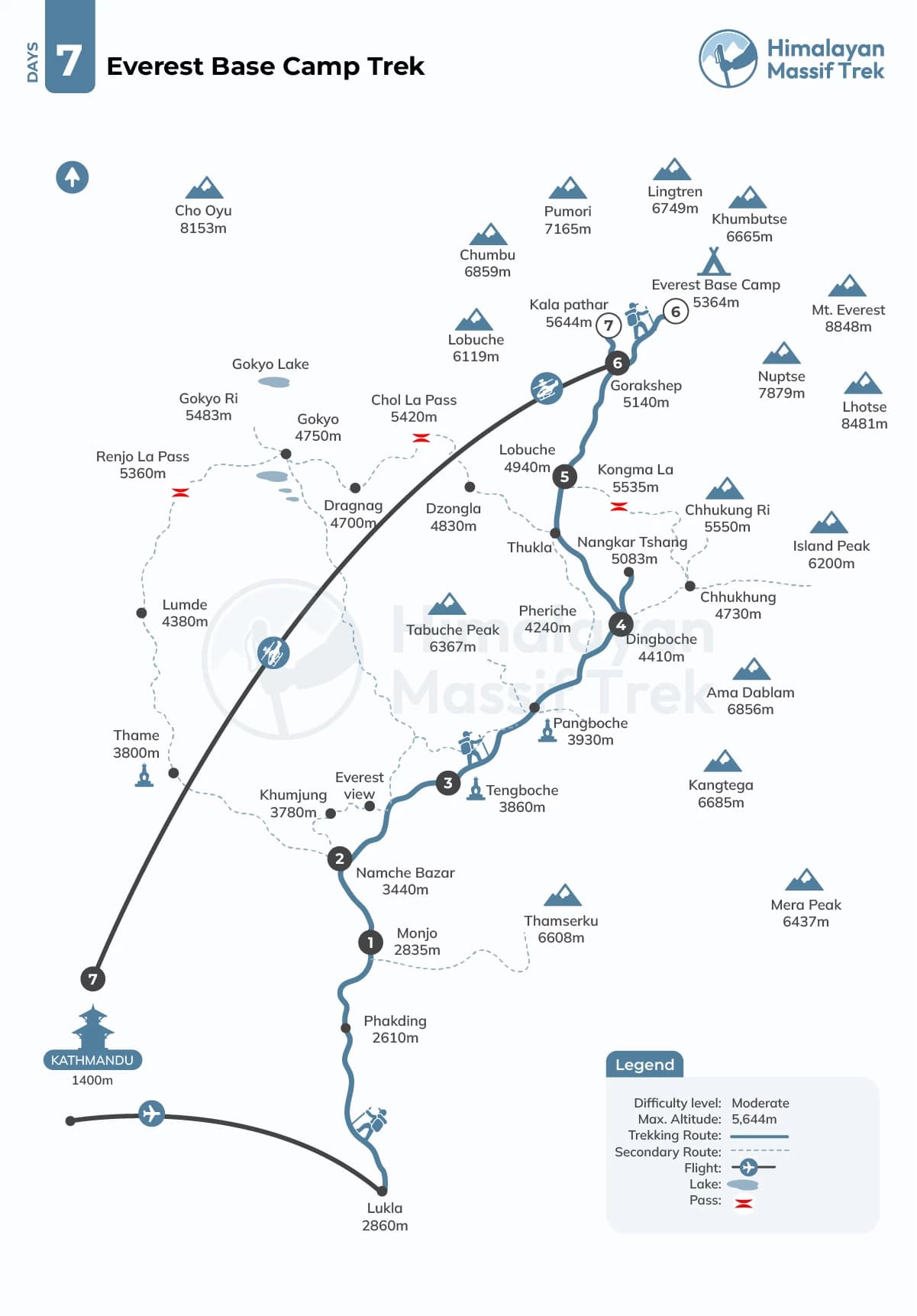

Cost Details
Accommodation:
- 6 nights comfortable lodge during the trek (Attached Bathroom in Namche-1 night, Phakding-1 night, Dingboche- 1 night)
Meals:
- 3 Standard meals a day ( Set of breakfast, Lunch and dinner)
- Farewell dinner in Kathmandu on the last night
Transportation and flights:
- Domestic airport pick up and drop
- Flight to Lukla from Kathmandu or Ramechhap
- Helicopter flight back from Gorakshep to Kathmandu on day 7
- Drop to Ramechhap (during April, May, October and November)
Guide and porters:
- A highly experienced guide and an assistant guide if the group size is bigger than 6 people.
- A strong porter between two trekkers (he carries up to 20kg of baggage)
Permit and document:-
- Local government fees
- National park entry permit
Trekking gears:
- Sleeping bag and down jacket to use for the trek
- HMT T-shirt and duffel bag for free
- First aid kit
Miscellaneous:
- Salary, food and accommodation for guide and porters
- Government taxes and liabilities
- International airfare
- Accommodation in Kathmand
- Travel Insurance and Nepal visa fee
- Lunch and dinner in Kathmandu
- Personal expenses include phone bills, cold and alcoholic drinks, laundry bills.
- Personnel trekking gear
- Tipping for trekking guide and porters
To confirm your payment, a deposit payment is required, which is 30% of the total booking price. This deposit helps us secure permits, logistics, and other necessary arrangements for your trek.
We understand that plans can change, and we strive to be as flexible as possible. However, to cover operational costs, a cancellation fee applies. This is a percentage of your total booking price and is deducted from the deposit payment.
Cancellation Fees
Cancel 30% days before departure: 5% of the trip cost
Cancel between 10 to 30 days before departure: 10% of the trip cost
Cancel within 10 days of departure: 20% of the trip cost
If you need to cancel, please notify us as early as possible to reduce charges.
Rescheduling
Unexpected circumstances can disrupt travel plans, even if you still want to do the trip. To support our clients, we have generously waived all rescheduling fees. You can postpone and reschedule your trip at no additional cost, as long as the new departure date falls within one year of your original booking.
Upgrades
If you wish to upgrade your accommodation, transportation, or any other services not mentioned in the Trip Includes section, please be aware that these upgrades will incur additional costs. We can assist in arranging these options for you based on your preferences and availability.
Lukla Plane Flights
Non-Refundable Flight Ticket: If you need helicopter evacuation or other means of transport due to altitude sickness or any other condition, your return flight ticket fare is non-refundable.
Refundable Flight Ticket: If the flight operator cancels your flight due to bad weather in Lukla, Kathmandu, or any other reason, your flight ticket fare is 100% refundable.
Helicopter Flights
Helicopter Return: If you need helicopter evacuation or other means of transport due to altitude sickness or any other condition, your helicopter return flight ticket fare is non-refundable.
Medical Evacuation: Please note that conditional medical evacuation by helicopter is not a part of your return flight. Should you require a medical evacuation, an extra fee for heli transportation will apply. This is covered by the client themselves or their travel insurance provider.
Dates & Availability
Private TripIf you don't find an appropriate date, you can propose a Preferred Departure Date, and we’ll ensure the trip runs as scheduled just for you.
Trip Gallery
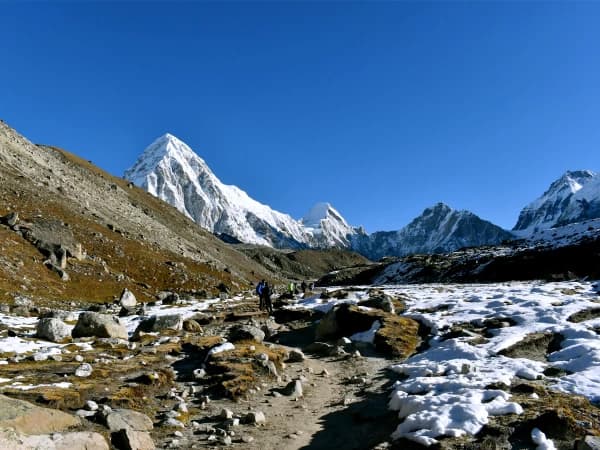
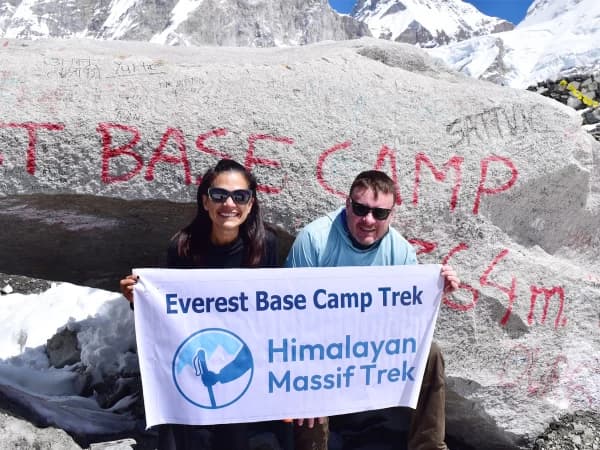
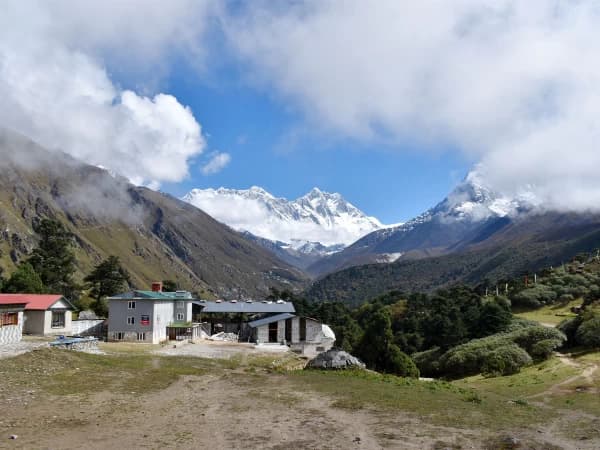
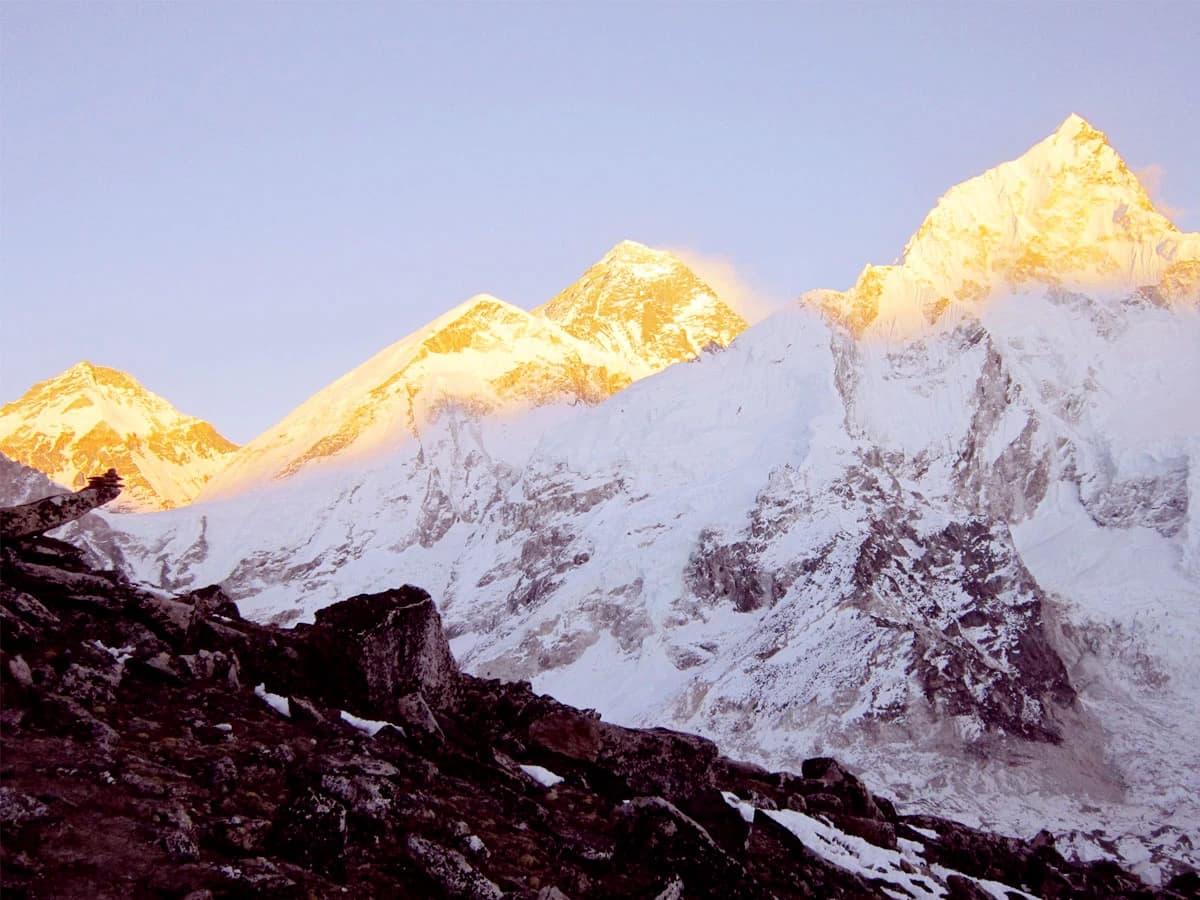
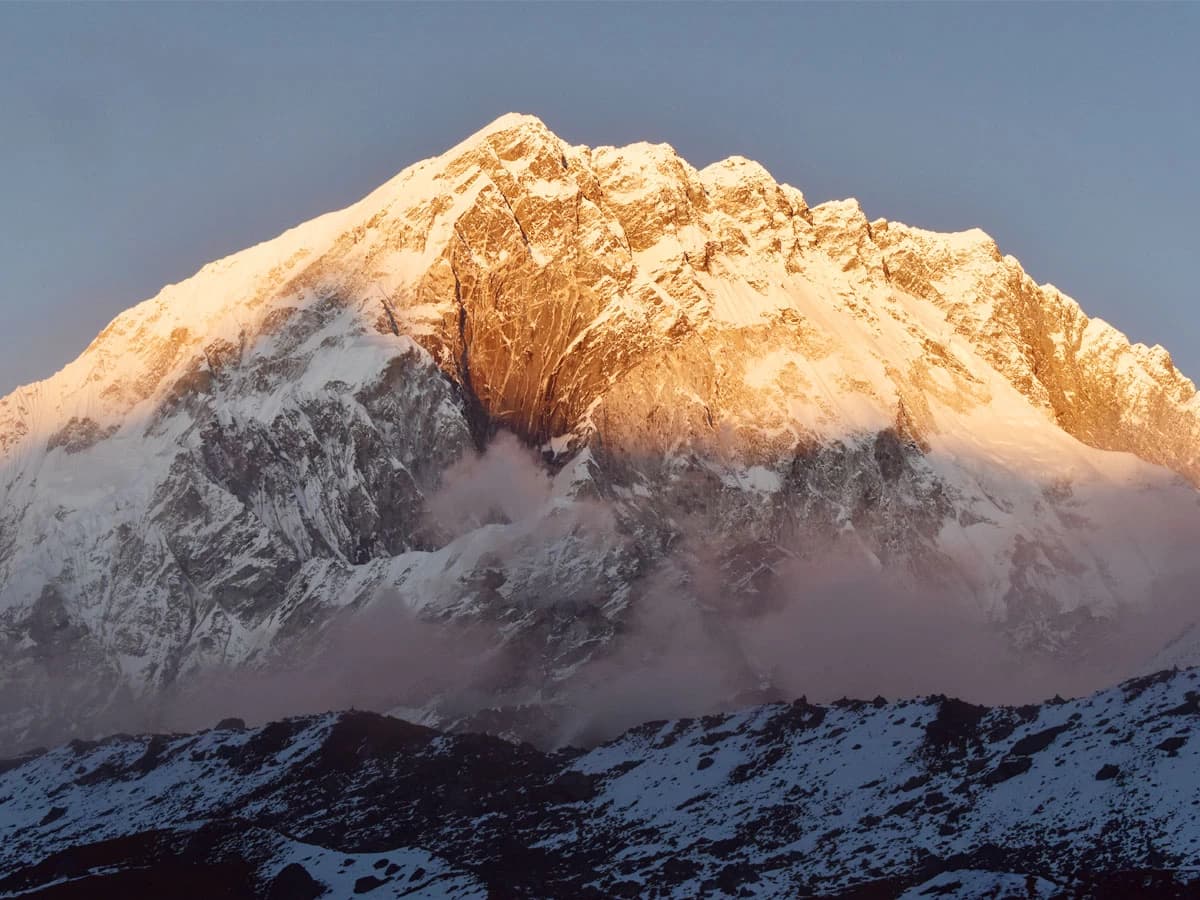
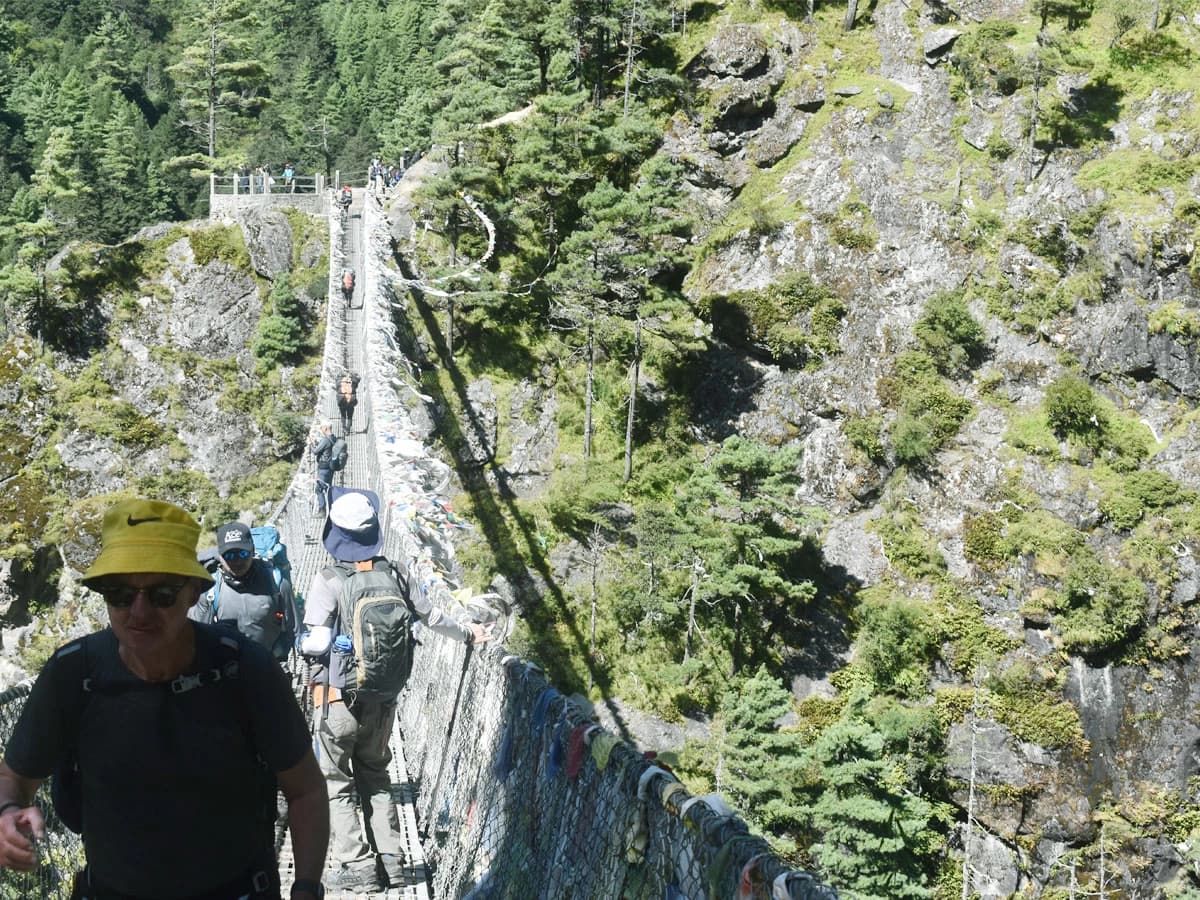
Essential Information
Best Time for the Adventurous 7-Day EBC Trek
While the Everest Base Camp Trek offers an unforgettable adventure, timing plays a crucial role in maximizing your experience. Choosing the right season ensures stable weather, awe-inspiring views, and a more enjoyable journey. The best times for the trek are spring (March to May) and autumn (September to November) due to their favorable conditions.
Peak Season (Pleasant Weather, Crowds):
1. Spring (March-May): Spring is a highly popular trekking season, offering sunny days, excellent visibility, and moderate temperatures. The trails come alive with blooming rhododendrons, creating scenic landscapes. Early mornings offer clear views of Everest's peaks, while April and May witness a bustling base camp filled with mountaineers preparing for their ascents. To enjoy the best of spring, aim for the middle of the season.
2. Autumn (September - November): Autumn, particularly late September to November, provides clear skies and stable weather. The temperatures are cooler than in spring, but the fresh air rewards trekkers with unmatched views of Everest and the surrounding peaks. October is especially popular for its perfect weather and fewer chances of rainfall. The vibrant trails, refreshed by monsoon rains, add a unique charm to this season.
Off-Season Options (For Experienced Trekkers):
1. Winter (December - February): For the adventurous spirit, winter trekking offers a unique and unforgettable experience. While extremely cold with temperatures dropping to -25.9°C at night, the clear skies and solitude make it a rewarding challenge. However, be prepared for limited services and extreme cold.
2. Monsoon Season (June - August): Heavy rains and slippery trails make this the least recommended season for trekking. Landslides and blurred views can pose challenges, but determined adventurers might find comfort in the quiet and unique experiences.
Key Considerations for Your 7-Day EBC Trek:
- Weather: Choose a season with clear skies and stable weather for the best views.
- Crowds: If you prefer a quieter trek, consider the off-season (early spring/late autumn) or winter (for experienced trekkers).
- Temperature: Choose a season that aligns with your comfort level. Spring and autumn offer milder temperatures, while winter is significantly colder.
- Festivals: Be aware of major festivals in Nepal, like Dashain (September/October,) which might affect travel plans or costs.
Travel Insurance
Undertaking the Everest Base Camp Trek is an exciting adventure, but it also presents challenges like unpredictable weather, rugged terrain, and high-altitude risks. Being prepared for these uncertainties is essential, and travel insurance offers the necessary protection to ensure a worry-free journey.
Altitude sickness is one of the most common risks during the trek and may require urgent medical attention or even helicopter evacuation. These services can be expensive, but travel insurance ensures you receive timely care without financial stress. Knowing you're covered allows you to fully immerse yourself in the adventure.
Additionally, travel insurance protects your finances if your trip is interrupted or canceled due to unforeseen events like natural disasters, political unrest, or personal emergencies. It can reimburse non-refundable expenses for accommodation or transport and provides coverage for lost or damaged belongings, keeping your plans on track.
When choosing travel insurance, look for policies tailored to high-altitude trekking. Research different providers, compare coverage options, and prioritize policies that include comprehensive medical care, trip interruption coverage, and emergency evacuation. With the right policy, you can confidently embark on your Everest Base Camp journey, knowing you're well-prepared for any unexpected challenges.
Everest Base Camp Trek 7 Days Equipment List
FAQs
The trek is moderately challenging because of the high altitudes and changing terrain.
Prior trekking experience is compulsory for this trek. However, having good physical fitness and some hiking experience can be helpful. Since the trek involves walking for several hours daily and managing high altitudes, it’s important to prepare yourself physically before starting the journey.
The trek can be physically challenging as you will walk for several hours daily and gain altitude along the way. Being in good physical shape and preparing with regular exercise and training will help you enjoy the experience more comfortably.
The highest altitude you will reach on this trek is 5,643 meters at Kala Patthar.
To stay safe, it's important to follow your guide's advice, drink plenty of water, and take time to adjust to the altitude.
You will need a Sagarmatha National Park permit, a local area permit from the Pasang Lhamu municipality for this trek, and a Trekkers' Information Management System (TIMS).
The cost of the trek depends on the company, what’s included, and the level of service offered. It’s best to contact trekking companies directly for accurate pricing details.
Yes, during the trek, you will have the chance to meet the Sherpa people and learn about their culture and traditions.
It's important to respect local customs, dress modestly, and always ask for permission before taking photos of people.
Yes, there are WIFI hotspots along the Everest Base Camp trail. However, due to the mountainous terrain, the connection can be unreliable at times. The signal may be weak or lost occasionally.
Experienced Local Guides – Our team is made up of experienced, local guides who know the Everest region inside and out. Our team will ensure your 7-Day Everest Trek is safe and truly special, sharing their deep understanding of the culture, trails, and terrain.
Authentic Cultural Experiences – We offer authentic experiences in alluring Sherpa villages like Tengboche, Dingboche, and Gorakshep. You'll enjoy traditional Sherpa meals and learn about the local people's traditions, lifestyle, and warm hospitality, making your trek a rich cultural adventure.
Great Value – We provide excellent value for your money. Our prices are competitive, and there are no hidden costs. Everything is included, from permits and comfortable places to stay along with delicious meals. We even offer discounts for groups and those who travel with us more than once.
Eco-Friendly Trekking – Himalayan Massif Trek cares about the environment. We employ eco-friendly trekking practices and support local businesses to help protect the beautiful Himalayas. We're also committed to sustainable travel, ensuring that the local communities and stunning landscapes are preserved for everyone to enjoy for generations to come.
- Expertise in High-Altitude Trekking Adventures
- Over 18 Years of Experience in The Himalayas
- Authorized and Reliable Trekking Partner
- Trusted by Thousands of Adventurers Worldwide

The 8-day EBC trek was challenging but doable with the support of the Himalayan Massif Trek team. The guides were experienced and made sure we...
The 8-day EBC trek was well-organized and efficient. The team made sure we were safe and comfortable throughout the journey. The views were breathtaking, and...
This trek was perfect for someone with limited time. The team made sure we made the most of our 8 days, and the views were...
